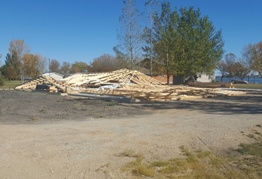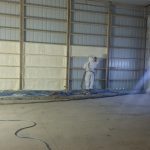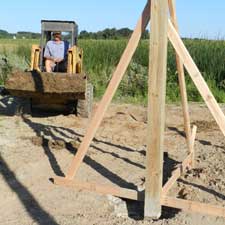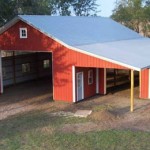Winds and Stick Frame Construction
This first appeared at www.ValleyNewsLive.com on Monday Oct. 12, 2015:
“High winds caused a building under construction to fall in Fargo Monday.
Parts of a building in the 300-block of 39th Street south, near the Flying J truck stop, fell apart after 1:00 p.m. Monday.
City building inspectors say they will survey the damage.
Winds have reached close to 60 mph in the Fargo-Moorhead area. The high gusts also knocked out power to some 4,000 customers in Fargo early Monday.”
 Another stick framed building under construction blew over near Browns Valley, Minnesota the same afternoon.
Another stick framed building under construction blew over near Browns Valley, Minnesota the same afternoon.
Let’s discuss wind forces first. Under the 2012 IBC (International Building Code) the lowest design wind speed (Vult) for this area of the country is 105 mph (miles per hour). https://publicecodes.cyberregs.com/icod/ibc/2012/icod_ibc_2012_16_sec009.htm
This equates to a pressure of 28.224 psf (pounds per square foot), which is calculated by multiplying the wind speed squared by .00256.
How about a 60 mph wind? Only 9.216 psf, or under 1/3 of the design capacity of the ‘completed’ building. The catch here being – completed.
Partially sheathed (sided and roofed) stick frame buildings are particularly susceptible to damage by winds, as in the partially enclosed state, they often behave as a balloon, with the wind pressure increasing inside until the building literally explodes.
Back in my early prefabricated wood roof truss days, we had supplied the roof trusses for the post office in Thompson Falls, Montana. The building was fully sheathed with plywood, however a plethora of window openings were left on one side of the building.
We heard from the contractor after a fluke high wind event literally sucked the walls out from under the roof system!
An alternative construction method, post frame (also known as pole building or pole barn) construction, could potentially be a solution to such during construction issues. With continuous columns properly embedded in concrete backfill to resist wind forces of uplift or overturning, the main framework remains intact in cases such as the collapses above.










While I wouldn’t disagree that a post frame structure would be more resistant to collapse, any incomplete structure that is not properly braced is likely to suffer failures of some magnitude in “rare” wind events.
Agreed – Any framed only building of any type wood or steel that is not braced correctly has a potential for failure. The point being that a post frame structure would be more resistant to it at this point due to the poles providing a much larger ability to resist the wind forces as they are buried deep in the ground compared to a stick framed structure that is by design much more flexible at this point. This was not a rare wind event and probably could have been prevented with better bracing but the stick frame structure is more prone to this type of failure.